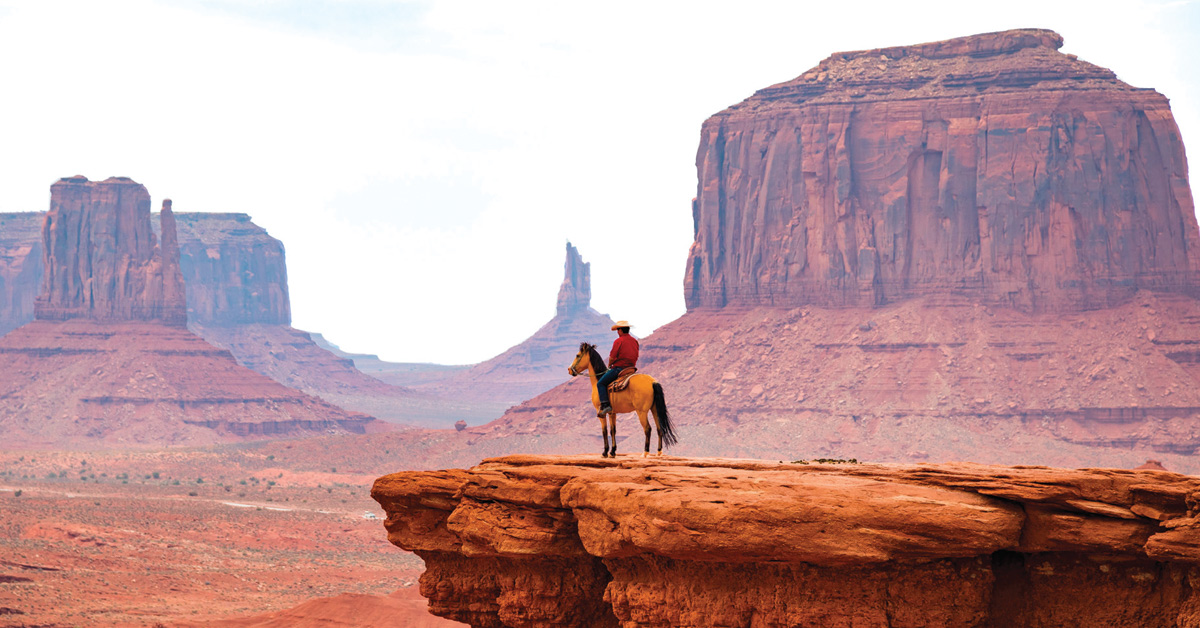The U.S. obtained the territory that became the Southwest Region states of Arizona, Utah, Nevada and New Mexico through the Treaty of Guadalupe Hidalgo, which was signed in 1848 and ended the Mexican-American War. It took many years, however, for these areas to eventually be granted statehood.
Today, these Southwestern states share some of the most stark, wondrous scenery in America. The four states combine to feature 11 of the 61 national parks, or nearly one in five. These natural areas include the red cliffs of Zion National Park in Utah, Death Valley National Park in Nevada, and the Grand Canyon and Petrified Forest parks in Arizona.

Tourism is a major industry for all four states. Grand Canyon ranks second among the most-visited national parks while Zion ranks fourth, with the pair combining to bring in more than 10 million visitors in 2019.
This past April, WalletHub ranked Nevada third on its list of states hardest hit by the coronavirus epidemic. The Las Vegas Strip shut down its casinos in mid-March for the first time since John F. Kennedy’s assassination in 1963. In 2018, more than 164,000 people were employed at hotels and casinos in Southern Nevada, or about one in six jobs in the region.
The NFL cancelled its draft in Sin City, which would have likely brought in tens of thousands of spectators and hundreds of millions of dollars in revenue. In 2019, Nashville hosted the NFL draft and the economic boon was calculated at $224 million for that city. Vegas was expecting an even larger impact.
Nevada’s gaming industry wasn’t the only regional attraction to be hit. New Mexico’s tourism industry brings in about $7 billion each year with its sights, art markets and unconventional attractions like Meow Wolf in Santa Fe. Utah, with its mix of parks and ski resorts, was losing millions of dollars per day. Arizona has a thriving short-term rental-housing market and the pandemic has proven to be an economic disaster for the state.
Each of the four states also rely heavily on resource extraction. Some of the largest mines in the world by production, size and value are located in Nevada, Arizona and Utah. Nevada ranked No. 1 and Arizona was No. 2 in the nation in 2019 with $8.19 billion and $6.97 billion, respectively, in the value of minerals mined, according to the U.S. Geological Survey.
Utah came in at No. 7 on the list at $3.32 billion and features the largest mine in the world, the Bingham Canyon copper mine, which covers 1,900 acres southwest of Salt Lake City. New Mexico ranked 28th on the list ($1.1 billion), but the state also ranked third in the U.S. for oil production with 339 million barrels in 2019.
Southwest Home Values
Home values in Utah ($355,484), Nevada ($309,730) and Arizona ($277,574) were higher than the U.S. average of about $249,000 this past March, according to Zillow, with New Mexico trailing at $210,141. As of January 2020, CoreLogic’s Loan Performance Insight Report found little concern with the four states in terms of delinquencies and foreclosures.
At that time, all four states were at or below the national 30-day delinquency rate of 3.5%. Although New Mexico (0.6%) and Nevada (0.4%) exceeded or equaled the U.S. foreclosure rate of 0.4%, the numbers were still historically low. Arizona’s foreclosure rate was 0.2% and Utah’s was 0.1%.
The Brookings Institution named mining, oil and tourism — all major industries in the Southwest Region — as industries most vulnerable to the coronavirus outbreak. Las Vegas and Phoenix, two areas hard hit during the Great Recession, were expected to again be hurt by an anticipated recession. Cities like Provo, Utah, which have large numbers of tech jobs, should fare better.

Focus: Mining
Nearly one quarter of the nonfuel mineral production in the U.S. is extracted in the Southwest states. In 2019, $19.6 billion of gold, copper and other precious metals, as well as gravel, sand and lime, was mined in the Southwest Region, according to the U.S. Geological Survey (USGS). The U.S. produced a total of $86.3 billion in minerals last year.
The USGS last tracked state-by-state employment numbers for the mining industry in 2014. These numbers provide a snapshot of the industry’s current importance for the Southwest states. At that time, Nevada employed 11,700 at mines, mills and plants with an average salary of $88,482. Arizona employed another 10,500, while Utah and New Mexico each employed more than 3,500. The average salary for each of these three states exceeded $69,000. The coronavirus outbreak was causing worldwide disruptions for the mining industry, both in terms of government-mandated work restrictions as well as outbreaks occurring at mines. Mineral production in the Southwest states is nearly certain to be affected in 2020.
What the locals say
“Utah has seen fewer cases of COVID-19 than most other states. We have still experienced a lot of unemployment filings in our state, but homebuying is still doing well in our area. Many Realtors and builders have changed the ways they are marketing homes, with virtual tours on social media and virtual walk-throughs via FaceTime. I have a builder referral partner that has been able to add virtual tours to their website. … This particular builder had record sales in March [2020] and it was one of their top-three sales months in their history.”

Danielle Young
Senior vice president of mortgage lending
Guaranteed Rate
3 Cities to Watch
Salt Lake City

A group of Mormon pioneers founded Salt Lake City in 1848, the first non-Native Americans to settle permanently in the Salt Lake Valley. The Utah capital was built next to the Great Salt Lake and the snow-capped Wasatch Range. About 200,000 people live in Salt Lake City with a total of 1.1 million in Salt Lake County. The University of Utah, Intermountain Healthcare and the state government are the county’s largest employers with about 20,000 workers each.
Elko

Founded in 1868, Elko became a critical stop on the transcontinental railroad in Northeastern Nevada, eventually growing into a city of about 20,000 residents today. Located on the Humboldt River, it is home to thousands who are employed at several major mines in the area. Thousands of tourists flock to the city each year for the National Cowboy Poetry Gathering. Elko County (population 53,000) has a median household income of $77,209 and a median home price of about $200,000.
Santa Fe

Located the foothills of the southern Rocky Mountains, Santa Fe is America’s second-oldest city, having been founded in the early 1600s. The New Mexico capital is now an artist’s enclave with cultural and historical offerings that attract 1 million visitors each year. Santa Fe also is home to Los Alamos National Laboratory, part of the Manhattan Project to design and create the atomic bomb. There are about 85,000 residents in the city and about 150,000 in Santa Fe County.
Sources: 911 Metallurgist, City of Santa Fe, CoreLogic, Fortune, Elko County, KTAR-FM, Las Vegas Review-Journal, Los Angeles Times, Mine Magazine, National Park Service, Online Nevada Encyclopedia, Our Documents, Salt Lake City Weekly, State Symbols USA, The Brookings Institution, The Salt Lake Tribune, Tourism Santa Fe, U.S. Bureau of Labor Statistics, U.S. Census Bureau, U.S. Energy Information Administration, U.S. Geological Survey, Utah Department of Workforce Services, Utah.com, Visit Salt Lake, WalletHub, WorldAtlas, Zillow








